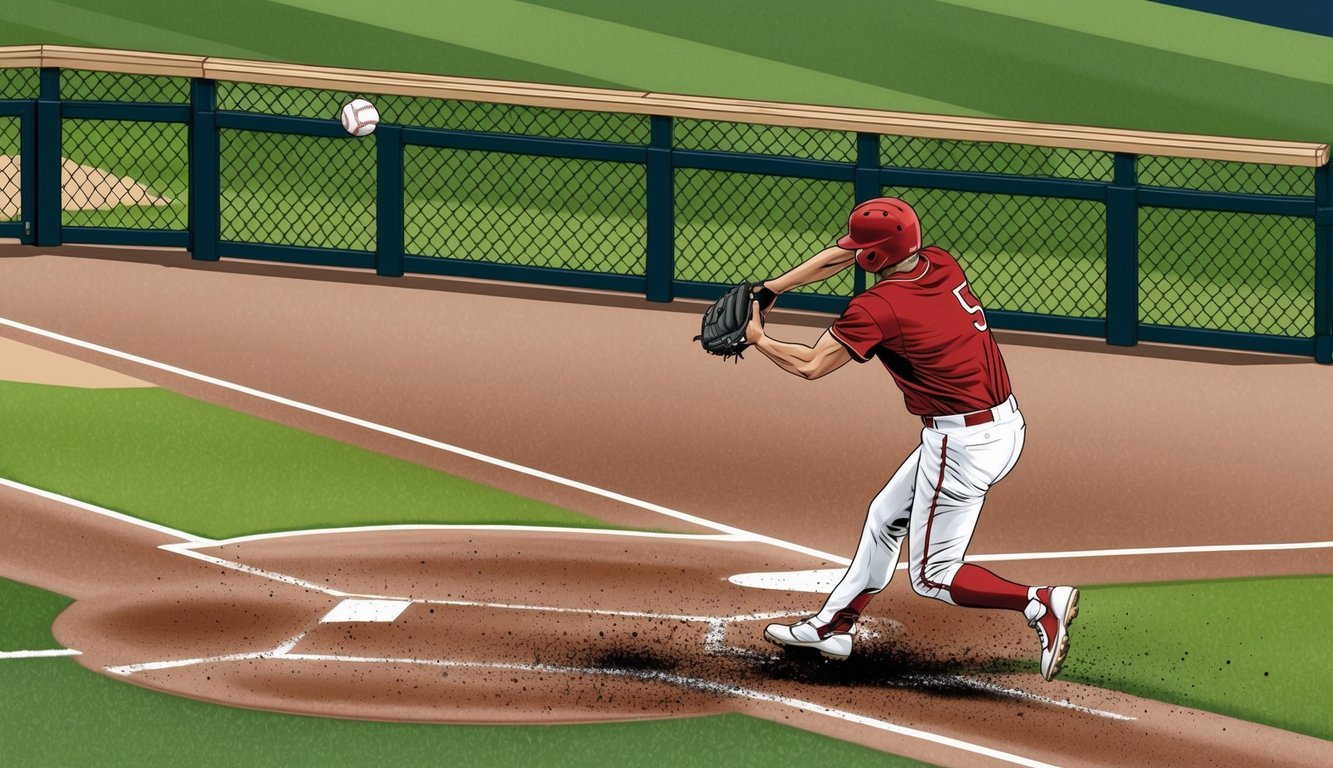Baseball is a game of strategy, skill, and scoring.
At the heart of every baseball match lies the pursuit of runs – the lifeblood of the sport that determines the winner. A run in baseball occurs when a player successfully advances around all four bases and touches home plate before three outs are recorded. This fundamental concept drives the excitement and tension of every at-bat and defensive play.
Scoring runs is the primary objective for the offensive team.
Players must navigate the base paths, starting from home plate and progressing through first, second, and third base before returning home.
This journey can unfold in various ways – from a single mighty swing resulting in a home run to a series of strategic plays that advance runners methodically around the diamond.
The art of scoring and preventing runs shapes the entire game.
Pitchers aim to keep runners off the bases, while batters and baserunners work together to create scoring opportunities.
Every stolen base, sacrifice bunt, or clutch hit serves the ultimate goal of crossing home plate and adding to the team’s run total.
Understanding runs is key to appreciating the nuances and thrills of America’s pastime.
Understanding the Basics of Baseball Scoring
Baseball scoring revolves around runs, which are the fundamental units of points in the game.
Teams aim to accumulate runs while preventing their opponents from scoring.
The Objective of Scoring Runs
A run occurs when a player successfully touches all four bases in order.
This journey typically starts at home plate, continues through first, second, and third base, and ends back at home plate.
Players can advance around the bases through various means:
- Base hits (singles, doubles, triples)
- Home runs
- Walks
- Errors by the opposing team
- Stolen bases
Each time a player completes this circuit, their team earns one run.
The team with the most runs at the game’s end wins.
Key Terms in Baseball Scoring
Several important terms are used in baseball scoring:
- RBI (Runs Batted In): Credits given to batters who enable runs to score
- Earned Run: A run scored without the aid of errors or passed balls
- Unearned Run: A run that scores due to an error or passed ball
Scorekeepers track these statistics along with:
- Hits
- Errors
- Stolen bases
- Pitch counts
This data helps managers make strategic decisions and provides a comprehensive record of the game’s events.
Fans often use these stats to analyze player and team performance.
How a Run is Scored in Baseball
Scoring a run in baseball requires a player to touch all four bases in order.
This pivotal aspect of the game can occur through various hitting and baserunning scenarios.
One of the most intriguing ways a player can reach home plate is through a fielder’s choice, where the defensive team opts to make a play on a different baserunner instead of the one advancing to a base.
This strategic decision can lead to surprising outcomes, as it allows the batter to reach first base safely, thereby increasing their chances of scoring.
Understanding the fielder’s choice explained in detail can shed light on the tactical nuances that define the sport and influence team dynamics.
From Bat to Home Plate
A batter becomes a baserunner after hitting the ball safely or drawing a walk.
From first base, the runner advances by stealing or on subsequent hits.
Reaching second base puts the runner in scoring position.
At third, the runner is just 90 feet from home.
Alertness is key – baserunners must watch for wild pitches or passed balls to advance.
They also rely on teammates to drive them in with hits.
Smart baserunning can make the difference between scoring and being stranded.
Types of Hits and Their Impact on Runs
Different hits create varied scoring opportunities:
- Singles: Advance runners 1-2 bases
- Doubles: Often score runners from second
- Triples: Usually clear the bases
- Home runs: Guaranteed run(s)
A bloop single might score a runner from second, while a sharp double could plate two.
Home runs are the most dramatic, instantly adding 1-4 runs to the scoreboard.
Situational hitting matters too.
A sacrifice fly scores a runner from third.
A well-placed bunt can surprise the defense and lead to a run.
Player Contributions to Run Scoring

Players contribute to run scoring in various ways, from driving in runs to capitalizing on defensive mistakes.
Their actions at the plate and on the basepaths directly impact the team’s ability to put points on the board.
The Role of RBIs
Runs Batted In (RBIs) measure a player’s ability to bring runners home.
A batter earns an RBI when their hit, sacrifice fly, or ground out allows a teammate to score.
Home runs often result in multiple RBIs, as the batter drives in themselves and any runners on base.
Power hitters typically accumulate more RBIs due to their ability to hit the ball far.
However, consistent contact hitters can also rack up RBIs by getting timely hits with runners in scoring position.
RBIs are a key statistic for evaluating a player’s offensive contribution.
Teams often rely on their middle-of-the-order batters to drive in runs and change the game’s momentum.
Understanding Earned and Unearned Runs
Earned runs result from a batter’s skill or strategic play.
These occur when a runner scores without the benefit of fielding errors or passed balls.
Pitchers are held accountable for earned runs, which directly affect their ERA (Earned Run Average).
Unearned runs, on the other hand, stem from defensive mistakes.
If a fielding error extends an inning and a run scores afterward, it’s considered unearned.
These runs don’t impact a pitcher’s ERA but still count toward the team’s total score.
Fielding errors can turn the tide of a game, allowing runners to advance or reach base safely.
Smart baserunners take advantage of these mistakes, turning potential outs into scoring opportunities.
Understanding the difference between earned and unearned runs helps fans appreciate the nuances of run production and defensive play in baseball.
The Impact of Run Scoring on the Game

Runs are the heartbeat of baseball, shaping strategies and determining outcomes.
They influence how teams approach offense, defense, and pitching throughout each inning.
Run Scoring Strategies
Teams employ various tactics to maximize run production.
Managers often use hit-and-run plays to put runners in motion and create scoring opportunities.
Sacrifice bunts can advance runners into scoring position.
Power hitters aim for extra-base hits or home runs to drive in multiple runs at once.
Smart baserunning is crucial.
Stealing bases puts pressure on the defense and sets up easier scoring chances.
Taking extra bases on hits or defensive miscues can turn singles into doubles or even triples.
Lineup construction plays a big role too.
Managers typically place high on-base percentage hitters at the top to set the table for power hitters in the middle of the order.
The Role of Pitchers and Defense
Pitchers and defenders work together to prevent runs.
Pitchers use a mix of velocity, movement, and location to keep hitters off balance and induce weak contact or strikeouts.
They must also manage pitch counts to stay effective deep into games.
Infielders and outfielders position themselves based on hitters’ tendencies and game situations.
Quick reflexes and strong throwing arms help turn potential hits into outs.
Double plays can quickly erase scoring threats.
Catchers play a vital role in run prevention.
They call pitches, control the running game, and block balls in the dirt to keep runners from advancing.
In close games, defensive substitutions and specialized relievers often enter to protect leads in the late innings.
Historical Context and Memorable Moments

Baseball’s rich history is filled with incredible run-scoring feats and unforgettable games.
From legendary players who dominated the bases to nail-biting matches with astronomical scores, runs have always been at the heart of baseball’s most thrilling moments.
Record-Breaking Run Scorers
Rickey Henderson stands as the all-time leader in runs scored, with an astounding 2,295 over his career.
His speed and base-stealing prowess made him a constant threat to cross home plate.
Babe Ruth, another baseball icon, ranks second with 2,174 runs.
Ruth’s power-hitting revolutionized the game, turning home runs into a spectacle.
The New York Yankees, with their storied legacy, have produced many prolific run scorers.
Lou Gehrig and Mickey Mantle both exceeded 1,800 runs in their careers, cementing their places among baseball’s greatest.
Iconic Games with High Run Counts
The Chicago Cubs defeated the Philadelphia Phillies 26-23 in the highest-scoring Major League Baseball game in 1922.
This 49-run slugfest remains unmatched in MLB history.
In the 2007 World Series, the Boston Red Sox dominated Game 1 against the Colorado Rockies with a 13-1 victory.
This lopsided win set the tone for the Red Sox’s eventual series sweep.
Another memorable high-scoring affair occurred in 1999 when the Cleveland Indians beat the Boston Red Sox 22-4.
The game featured an 18-run inning by the Indians, tying the modern-era record for runs in a single inning.
